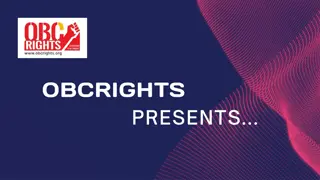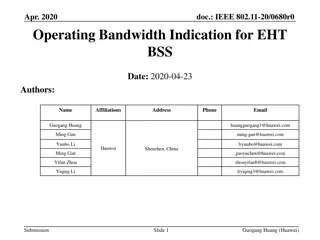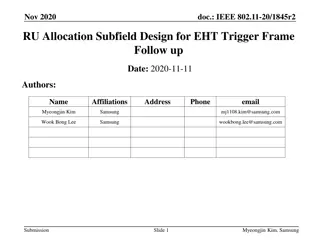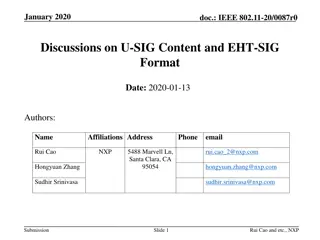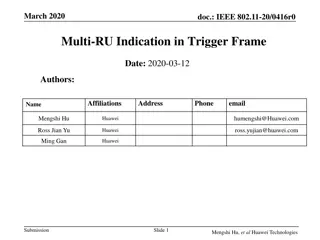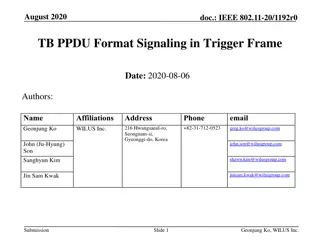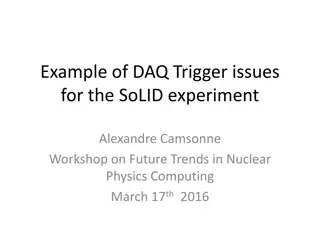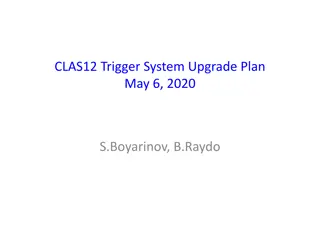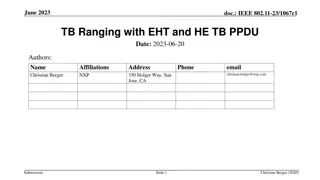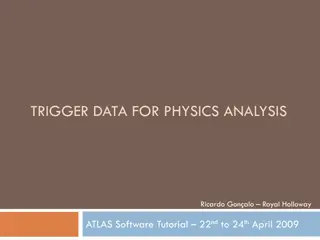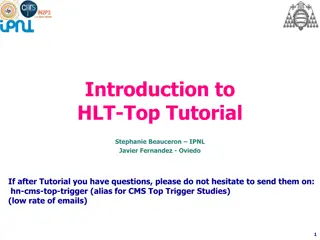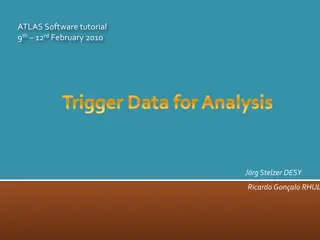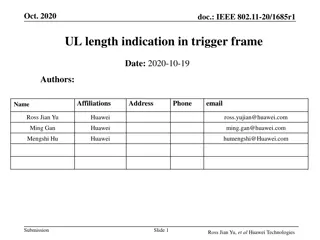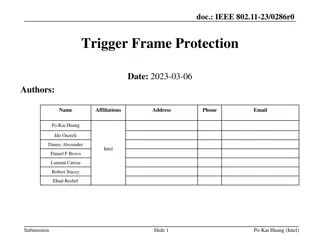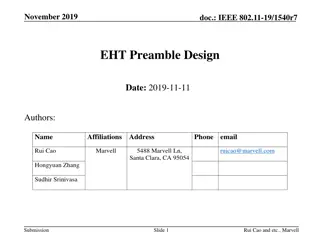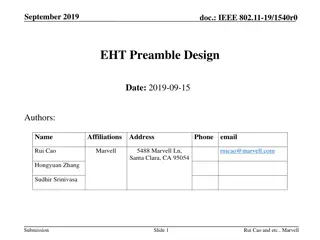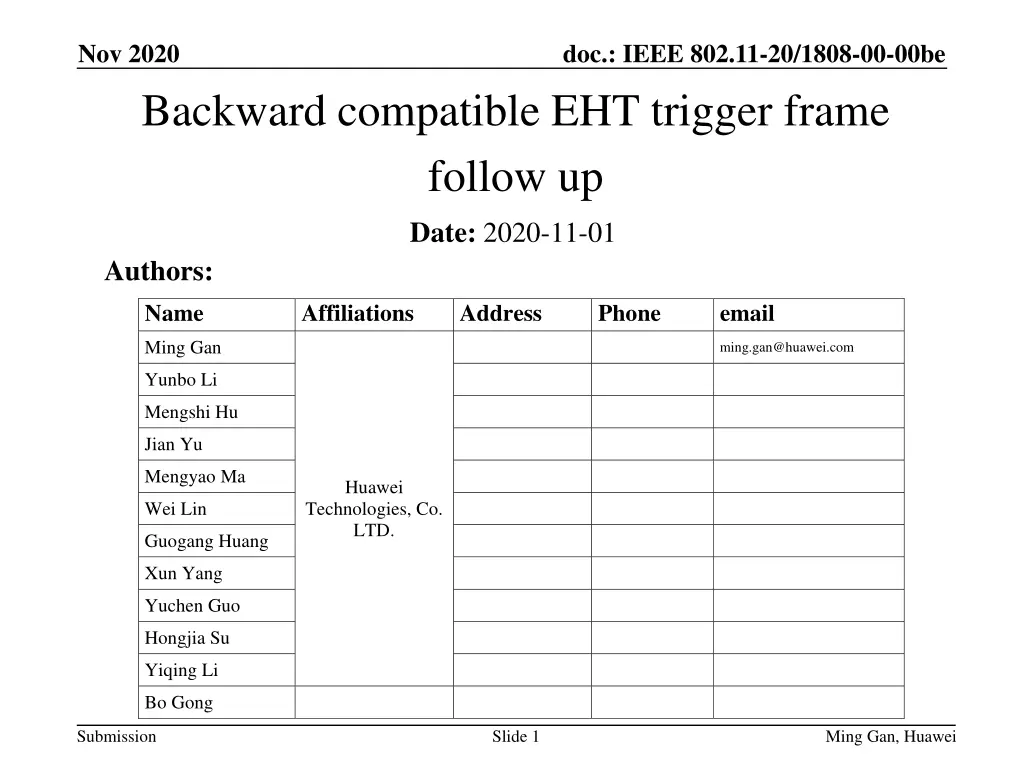
IEEE 802.11-20/1808-00-00be Backward Compatible Trigger Frame Details
Explore the details of the IEEE 802.11-20/1808-00-00be trigger frame, focusing on backward compatibility for HE and EHT STAs. Understand the structure, information fields, and remaining issues addressed for seamless integration. Discover the HE/EHT indication options and implications within the trigger frame design.
Download Presentation

Please find below an Image/Link to download the presentation.
The content on the website is provided AS IS for your information and personal use only. It may not be sold, licensed, or shared on other websites without obtaining consent from the author. If you encounter any issues during the download, it is possible that the publisher has removed the file from their server.
You are allowed to download the files provided on this website for personal or commercial use, subject to the condition that they are used lawfully. All files are the property of their respective owners.
The content on the website is provided AS IS for your information and personal use only. It may not be sold, licensed, or shared on other websites without obtaining consent from the author.
E N D
Presentation Transcript
Nov 2020 doc.: IEEE 802.11-20/1808-00-00be Backward compatible EHT trigger frame follow up Date: 2020-11-01 Authors: Name Affiliations Address Phone email Ming Gan ming.gan@huawei.com Yunbo Li Mengshi Hu Jian Yu Mengyao Ma Huawei Wei Lin Technologies, Co. LTD. Guogang Huang Xun Yang Yuchen Guo Hongjia Su Yiqing Li Bo Gong Submission Slide 1 Ming Gan, Huawei
Nov 2020 doc.: IEEE 802.11-20/1808-00-00be Background We agree that the trigger frame in 802.1be shall be backward compatible The same Trigger frame can be used to solicit the TB PPDU from both the HE STA(s) and EHT STA(s) All the Per User Info fields in a Trigger frame other than MU-BAR Trigger shall have the same size. One unified RU allocation table (for both SU and MU) for the RU allocation field in the User Info field of the Trigger frame Some remaining issue are still TBD for the trigger frame HE/EHT indication, a signalling that indicates TB PPDU format UL BW extension RU allocation table and SS allocation in the user info field In this contribution, we try to address the above remaining issues for backward compatible trigger frame Submission Slide 2 Ming Gan, Huawei
June 2020 doc.: IEEE 802.11-20/1808-00-00be Recap-HE trigger frame HE trigger frame is shown as below Common Info field and a list of User Info fields Submission Slide 3 Ming Gan, Huawei
Nov 2020 doc.: IEEE 802.11-20/1808-00-00be Trigger frame For the common part, it is easy for find the reserved bits by using the UL HE SIG- A reserved field or a special User Info field However, User Info field needs careful design since there is only one clean reserved bit now Subfield HE Bits EHT Bits Opt 2 [2] EHT Bits Opt 1 [1] EHT Bits Opt 1 [1] and [3] AID12 12 12 12 12 RU Allocation 8 8 8 8 UL FEC Coding Type 1 1 1 1 MCS 4 4 4 4 DCM 0 1 0 0 (Merges DCM with MCS) (Merges DCM with MCS) (Merges DCM with MCS) 0 SU/MU 0 1(0) 0 SS Allocation 6 6 6 6 (4+2 for MU-MIMO, 4 for SU) (4+2, only 4 ss for SU) (4+2, only 4 ss for SU) UL Target RSSI 7 7 7 7 HE/EHT Format 1 0 (move to Common) 0 (move to Common) P/S160 MHz or L/H 160 MHz 1 1 0 (by using a special user info) Reserved 1 0 1 1(2) Submission Slide 4 Ming Gan, Huawei
June 2020 doc.: IEEE 802.11-20/1808-00-00be HE/EHT indication HE/EHT indication is used to indicate which TB PPDU format the EHT STA is solicited to transmit There are two options Opt1: HE/EHT indication is in the Common part of the Trigger frame, that is per 80MHz segment [1] 2 or 4 bits for HE/EHT indication. It has two bits if we limit to HE PPDU only on Primary 160 MHz Opt2: HE/EHT indication is in the User Info field of the Trigger frame [2] 1 bit in each User Info field For EHT STA Overhead Opt 1 Opt 2 Small, only 2 or 4 bits Large, depending on the number of user fields At least one clean reserved bit No clean reserved bit (MSB of AID 12 field is debatable) Reserved bit Yes, it is easy to find bits in the common part No, there exists extensible signaling issue if it is in User Info field with fixed length, i.e., no space to accommodate EHT/EHT+/EHT++ indication Extensible Submission Slide 5 Ming Gan, Huawei
June 2020 doc.: IEEE 802.11-20/1808-00-00be HE/EHT indication and PHY Version Since A-PPDU is a feature in R2, so we propose EHT PPDU could transmit either EHT TB PPDU or HE TB PPDU HE/EHT indication in the common part has 2 bits, each bit corresponds to one 80 MHz segment within primary 160 MHz Moreover, EHT STA always transmits EHT TB PPDU in R1 PHY version in the trigger frame has overlapped function as EHT/HE indication and it is not needed Once one of them is known is by EHT STA, it could set the PHY version field in U-SIG of TB PPDU correctly PHY version just functions as 1 bit to EHT STA Submission Slide 6 Ming Gan, Huawei
June 2020 doc.: IEEE 802.11-20/1808-00-00be UL BW BW BW Bandwidth Expansion (B59) BW Expansion [3] This bit can be combined with the two-bit BW Field Possible bit mapping (on right) However, the simple bw extension can not work One example Simple extension can not cover the following solicited transmission 80 MHz for HE TB PPDU, 80 MHz for EHT TB PPDU 0 0 20 MHz 0 1 40 MHz 0 2 80 MHz 0 3 80+80 MHz or 160 MHz 1 0 320 MHz 1 1 Reserved 1 2 Reserved 1 3 Reserved Non-HT U-SIG L-P+RL Secondary 80MHz Non-HT U-SIG L-P+RL EHT M-BA Non-HT U-SIG L-P+RL Non-HT trigger U-SIG L-P+RL Non-HT SIG-A L-P+RL Primary 80MHz Non-HT SIG-A L-P+RL HE M-BA Non-HT SIG-A L-P+RL Non-HT trigger SIG-A L-P+RL TB PPDU Trigger frame Submission Slide 7 Ming Gan, Huawei
June 2020 doc.: IEEE 802.11-20/1808-00-00be UL BW Another example Simple extension can not cover the following solicited transmission 160 MHz for HE TB PPDU and 80 MHz for EHT TB PPDU Non-HT U-SIG L-P+RL Non-HT U-SIG L-P+RL EHT M-BA Non-HT U-SIG L-P+RL Non-HT trigger U-SIG L-P+RL Secondary 160MHz Punctured 80MHz channel SIG-A L-P+RL Non-HT SIG-A Secondary 80MHz L-P+RL Non-HT HE M-BA SIG-A Non-HT L-P+RL SIG-A L-P+RL Non-HT trigger Non-HT SIG-A L-P+RL Primary 80MHz Non-HT SIG-A L-P+RL HE M-BA Non-HT SIG-A L-P+RL Non-HT trigger SIG-A L-P+RL TB PPDU Trigger frame Submission Slide 8 Ming Gan, Huawei
June 2020 doc.: IEEE 802.11-20/1808-00-00be UL BW Moreover, we agreed that we need differentiate 320-1 from 320-2 for BW in DL PPDU [4] To help spatial reuse (identify OBSS PPDU) and intra-PPDU power save UNII6 /7 80 UNII7 /8 80 160 UNII5 UNII6 UNII7 UNII8 80 80 80 80 80 80 80 80 80 80 80 80 160 160 160 160 160 160 320-1 320-1 320-1 320-2 320-2 320-2 To keep consistent with U-SIG in DL PPDU, 320-1/2 indication in the trigger frame is also needed Submission Slide 9 Ming Gan, Huawei
June 2020 doc.: IEEE 802.11-20/1808-00-00be UL BW Two possible UL BW extension indications The left figure needs 1 bit , but can not cover 320-1/320-2 and can not reflect the real BW of HE PPDU and EHT PPDU in some cases The right figure works well, but it needs two bits BW BW Bandwidt h, MHz Bandwidth for HE STA, MHz Extension (2 bits) BW BW Bandwidth, MHz Bandwidth for HE STA, MHz Extension (1 bit) reserved 0 20 20 0 0 20 20 reserved 1 40 40 1 0 320 20 0 2 80 80 0 1 40 40 1 2 160 80 1 1 320 40 2 2 320 -1 80 0 2 80 80 3 2 320-2 80 0 80 160 3 1 2 320 80 1 3 160 160 0 3 160 160 2 3 320 -1 160 1 320 160 3 3 3 320-2 160 The other way is to have another BW field, it requires 3 bits No benefit compared with 2 bits UL BW extension but with more overhead Submission Slide 10 Ming Gan, Huawei
June 2020 doc.: IEEE 802.11-20/1808-00-00be Summary We propose a backward compatible trigger frame by adding the following fields HE/EHT indication per 80 MHz in the common part UL BW extension Submission Slide 11 Ming Gan, Huawei
June 2020 doc.: IEEE 802.11-20/1808-00-00be References [1] 11-20-0840-03-00be-backward-compatible-eht-trigger- fram [2] 11-20-1429-02-00be-enhanced-trigger-frame-for-eht- support [3] 11-20-1669-02-00be-spatial-stream-allocation-in- trigger-frames [4] 11-20-1467-00-00be-bw320-signaling Submission Slide 12 Ming Gan, Huawei
June 2020 doc.: IEEE 802.11-20/1808-00-00be SP 1 Do you agree to include a 2-bit EHT/HE indication where each bit corresponds to an 80 MHz within primary 160 MHz in the common part of the Trigger Frame , indicating to the EHT STA whether to transmit an HE or EHT TB PPDU in R2? Submission Slide 13 Ming Gan, Huawei
June 2020 doc.: IEEE 802.11-20/1808-00-00be SP 2 Do you agree to add the following UL BW extension to the common part of the Trigger frame in R1? BW BW Bandwidth, MHz Bandwidth for HE STA, MHz Expansion (2 bits) reserved 0 20 20 reserved 1 40 40 0 2 80 80 1 2 160 80 2 2 320 -1 80 3 2 320-2 80 0 80 160 3 1 3 160 160 2 3 320 -1 160 3 3 320-2 160 Submission Slide 14 Ming Gan, Huawei
Nov 2020 doc.: IEEE 802.11-20/1808-00-00be Appendix Submission Slide 15 Ming Gan, Huawei
June 2020 doc.: IEEE 802.11-20/1808-00-00be User Info field in trigger frame The following subfields in the User Info field may be impacted by the new features in EHT RU allocation subfield SS allocation subfield However, there is only one reserved bit in User Info field. From the philosophy of design, it is better to keep it. We propose to have a special User Info field to divide the User Info fields into two categories Keep the existing 8-bit RU allocation subfield, and add MRU mode and large RUs to 7-bit table (refer to appendix) RU allocation subfield in the 1st part indicates a RU within or larger than primary160 MHz RU allocation subfield in the 2nd part indicates a RU within or larger than second 160 MHz User Info 1 User Info 2 User Info X Special User Info User Info X+1 User Info X+2 User Info X+n The second part, the assigned RU is within or larger than secondary 160 MHz The first part, the assigned RU is within or larger than primary 160 MHz Submission Slide 16 Ming Gan, Huawei
June 2020 doc.: IEEE 802.11-20/1808-00-00be HE/EHT indication Example for Opt 1 An EHT AP sends non-HT duplicated trigger frame: two user info fields are for two EHT STAs, respectively. Both of these two User Info fields are EHT format HE/EHT=10 in the common part 1-HE 0-EHT Case 1: If EHT STA is assigned to some certain RU in S80/second 80 MHz, then it is solicited to send EHT TB PPDU Case 2: If EHT STA is assigned to some certain RU in P80/first 80 MHz, then it is solicited to send HE TB PPDU Non-HT U-SIG L-P+RL Secondary 80MHz Non-HT U-SIG L-P+RL EHT M-BA Non-HT U-SIG L-P+RL Non-HT trigger U-SIG L-P+RL Non-HT SIG-A L-P+RL Primary 80MHz Non-HT SIG-A L-P+RL HE M-BA Non-HT SIG-A L-P+RL Non-HT trigger SIG-A L-P+RL Trigger frame TB PPDU-UL Submission Slide 17 Ming Gan, Huawei
June 2020 doc.: IEEE 802.11-20/1808-00-00be HE/EHT indication Another example for Opt 1 An EHT AP sends non-HT duplicated trigger frame: two user info fields are for two EHT STAs, respectively. One user info field is EHT format the other one is HE format HE/EHT=10 in the common part 1-HE 0-EHT Case 1: If EHT STA is assigned to some certain RU in S80, then it is solicited to send EHT TB PPDU Case 2: If EHT STA is assigned to some certain RU in P80, then it is solicited to send HE TB PPDU Non-HT U-SIG L-P+RL Secondary 80MHz Non-HT U-SIG L-P+RL EHT M-BA Non-HT U-SIG L-P+RL Non-HT trigger U-SIG L-P+RL Non-HT SIG-A L-P+RL Primary 80MHz Non-HT SIG-A L-P+RL HE M-BA Non-HT SIG-A L-P+RL Non-HT trigger SIG-A L-P+RL Trigger frame TB PPDU-UL Submission Slide 18 Ming Gan, Huawei

